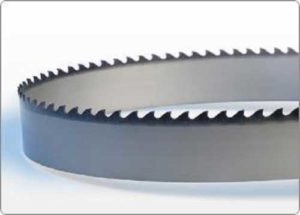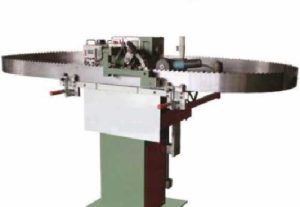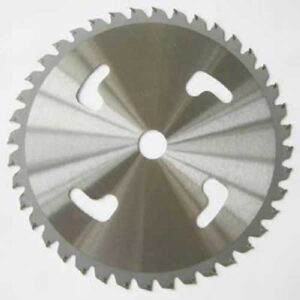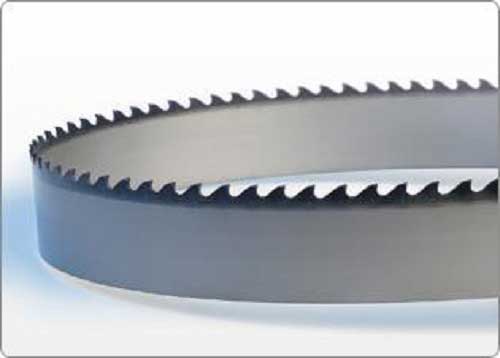Types of stainless steel and choice of saw blade type during sawing.(HY-industry technical centre)
Common categories:
Usually divided according to metallographic organization:
Generally, according to the metallographic structure, ordinary stainless steel is divided into three categories: austenitic stainless steels, ferritic stainless steels, martensitic stainless steels. On the basis of these three basic metallographic structures, for specific needs and purposes, dual phase steel, precipitation hardening stainless steels and high alloy steel with iron content less than 50% have been derived.
1. Austenitic stainless steels.The matrix is mainly austenite structure (CY phase) with face-centered cubic crystal structure, which is non-magnetic. The stainless steel is mainly strengthened by cold working (and may cause certain magnetism). The chromium content is higher than 18%, generally containing 8 % Nickel. . The American Iron and Steel Institute uses 200 and 300 series numbers, such as 304, and other grades such as 1Cr18Ni9 and 0Cr19Ni9.
 2. Ferrite stainless steels.The matrix is dominated by a body-centered cubic crystal structure of ferrite (a phase). This type of steel has good plasticity, toughness, and magnetism. It is generally not hardened by heat treatment, but cold working can make it slightly strengthened stainless steels. Corrosion resistance, toughness and weldability increase with the increase of chromium content. The American Iron and Steel Institute is marked with 430 and 446. Other brands are called Crl7, Cr17Mo2Ti, Cr25, Cr25Mo3Ti, Cr28, 15% ~ 30 %.
2. Ferrite stainless steels.The matrix is dominated by a body-centered cubic crystal structure of ferrite (a phase). This type of steel has good plasticity, toughness, and magnetism. It is generally not hardened by heat treatment, but cold working can make it slightly strengthened stainless steels. Corrosion resistance, toughness and weldability increase with the increase of chromium content. The American Iron and Steel Institute is marked with 430 and 446. Other brands are called Crl7, Cr17Mo2Ti, Cr25, Cr25Mo3Ti, Cr28, 15% ~ 30 %.
3. Martensitic stainless steel.The matrix is a martensitic structure (body-centered cubic or cubic), magnetic, high carbon content, high strength, hardness and wear resistance, stainless steels whose mechanical properties can be adjusted by heat treatment. The American Iron and Steel Institute is marked with 410, 420 and 440 numbers, and other grades such as 1Cr13 and 3Cr13. Martensite has an austenite structure at high temperature. When cooled to room temperature at an appropriate rate, the austenite structure can be transformed into martensite (ie, hardened)
4. Austenitic-ferrite (duplex) stainless steels.The matrix has both austenite and ferrite two-phase structure, and the content of the less-phase matrix is generally greater than 15%, which is magnetic and can be strengthened by cold working stainless steels. In the case of low C content, Cr content is 18% ~ 28%, Ni content is 3% ~ 10%. Some steels also contain alloying elements such as Mo, Cu, Si, Nb, Ti, and N. This type of steel has the characteristics of austenitic and ferritic stainless steels. Compared with ferrite, it has higher plasticity and toughness and is a nickel-saving stainless steels. Compared with austenitic stainless steels, dual-phase steels have high strength and significantly improved resistance to intergranular corrosion and chloride stress corrosion and pitting corrosion. 329 is a typical duplex stainless steels.
 Duplex stainless steel is classified according to its chemical composition and can be divided into four categories: Cr18, Cr23 (without Mo), Cr22, and Cr25. For Cr25 type duplex stainless steels, it can be divided into ordinary type and super duplex stainless steels. Among them, Cr22 type and Cr25 type are mostly used. The duplex stainless steels used in China are mostly produced in Sweden. The specific grades are: 3RE60 (Cr18 type), SAF2304 (Cr23 type), SAF2205 (Cr22 type), SAF2507 (Cr25 type), UNS S32304 (23Cr-4Ni-0.1N), UNS S31803 (22Cr-5Ni-3Mo-0.15N), UNSS32550 (25Cr-6Ni-3Mo-2Cu-0.2N)
Duplex stainless steel is classified according to its chemical composition and can be divided into four categories: Cr18, Cr23 (without Mo), Cr22, and Cr25. For Cr25 type duplex stainless steels, it can be divided into ordinary type and super duplex stainless steels. Among them, Cr22 type and Cr25 type are mostly used. The duplex stainless steels used in China are mostly produced in Sweden. The specific grades are: 3RE60 (Cr18 type), SAF2304 (Cr23 type), SAF2205 (Cr22 type), SAF2507 (Cr25 type), UNS S32304 (23Cr-4Ni-0.1N), UNS S31803 (22Cr-5Ni-3Mo-0.15N), UNSS32550 (25Cr-6Ni-3Mo-2Cu-0.2N)
5. Precipitation hardening stainless steels.The matrix is austenitic or martensite structure, and can be hardened by precipitation hardening stainless steels. The American Iron and Steel Institute uses 600 series of numbers, such as 630, that is 17-4PH.
Introduction of several special stainless steels
-
904L stainless steel. Super complete austenitic stainless steel is a kind of super austenitic stainless steel invented by Finland Outokumpu. Its nickel mass fraction is 24% to 26%, carbon mass fraction is less than 0.02%, and its corrosion resistance is excellent. The original standard ASMESB-625 classified it as a nickel-based alloy, and the new standard classified it as stainless steel. China only has the similar grade 015Cr19Ni26Mo5Cu2 steel.
-
440C stainless steel. Martensitic stainless steel has the highest hardness among hardenable stainless steels and stainless steels with a hardness of HRC57.
-
17-4PH stainless steel. Martensitic precipitation hardening stainless steel with a hardness of HRC44 has high strength, hardness and corrosion resistance and cannot be used at temperatures above 300 ° C.
Choice of sawing stainless steels saw blade
-
 Common martensitic, austenitic and ferritic stainless steels with hardness below 30HRC:When the production efficiency requirement is not high, the bimetal band saw blade can be used.However, when the production efficiency is relatively high and the life of the saw blade is high, you can choose the Bichamp-DT series or Tancut bimetal series products.When the production efficiency requirements are higher, it is recommended to select the universal split tooth CB-MP split tooth carbide band saw blade. When the requirements on the cutting surface of the workpiece are high, the TCB-MP series can be considered.
Common martensitic, austenitic and ferritic stainless steels with hardness below 30HRC:When the production efficiency requirement is not high, the bimetal band saw blade can be used.However, when the production efficiency is relatively high and the life of the saw blade is high, you can choose the Bichamp-DT series or Tancut bimetal series products.When the production efficiency requirements are higher, it is recommended to select the universal split tooth CB-MP split tooth carbide band saw blade. When the requirements on the cutting surface of the workpiece are high, the TCB-MP series can be considered. -
For stainless steels with hardness higher than 30HRC and lower than 40HRC, it is recommended to use CB-MP split tooth series (ordinary bimetal band saw blade). On the special carbide band saw machine, TCB-MP carbide band saw blade is recommended.
-
Especially high hardness stainless steels or duplex stainless steels, precipitation hardening stainless steels type, it is recommended to choose CB-PRO type is the most suitable. If it is a special hard alloy band sawing machine, you can choose TCB-PRO series.
Typical cutting parameters of 200mm round bar using bimetal band saw blade are as follows:
Cutting parameters of bimetal band saw blade(200mm round bar) |
Ordinary stainless steel |
Duplex stainless steel, precipitation hardening stainless steel |
Sawing speed(m/min) |
30 |
20 |
Sawing efficiency(cm2/min) |
20 |
10 |
Typical cutting parameters of 200mm round bar using carbide band saw blade are as follows:
Carbide band saw blade cutting parameters (200mm round bar) |
Ordinary stainless steel |
Duplex stainless steel, precipitation hardening stainless steel |
Sawing speed(m/min) |
60 |
40 |
Sawing efficiency(cm2/min) |
40 |
20 |
The cutting fluid is emulsified cutting fluid, the concentration of the bimetal band saw blade is 12% ~ 15%, and the concentration of the cemented carbide product is 15% ~ 20%.
HY-industry is qualified Nickelalloy&cobalt alloy materials supplier.
We have more than twenty years experience in kind of High temperature alloy production.
Inconel 718, Monel 400,Stellite 6,Stellite 12,Incoloy 800ht,Incoloy 901,Nimonic 80A,Kovar,Invar 36,Inconel 625,Hastelloy C276,MP35N, Incoloy 825 are mature productes of us.
When you want to know more about our products, please contact us:
http://hynickelalloy.com


